Lately I have been seeing more Chukars than I have through the winter when the Rough-legged Hawks were in the area in large numbers. Rough-legged Hawks primarily eat lemmings on their breeding grounds and voles when they are not but they will also eat rabbits, ground squirrels and birds year round. So perhaps with fewer Rough-legged Hawks the Chukars feel safer to forage more out in the open. I thought I would share a few older images along with some taken this past week.
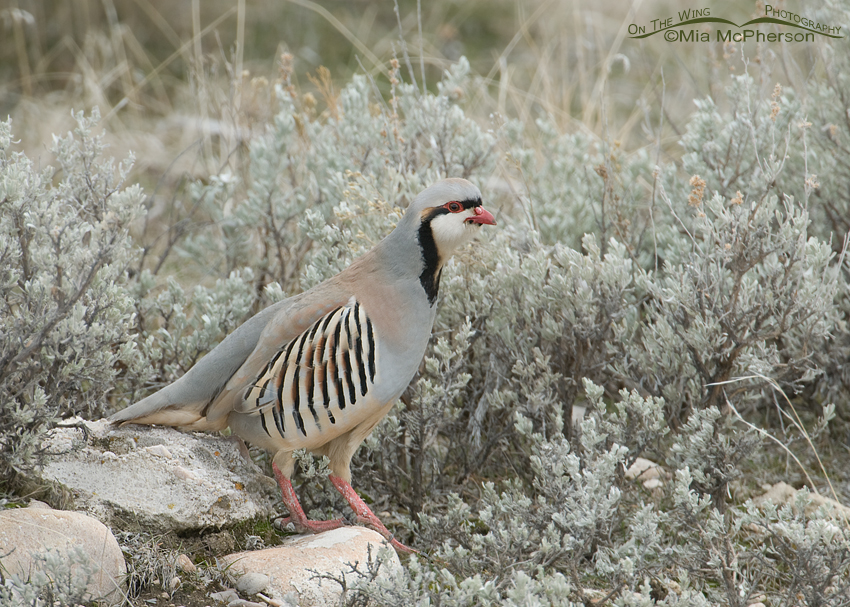 Chukar walking through Sagebrush
Chukar walking through Sagebrush
Chukars are not native to North America, they were introduced as game birds and in some areas they have thrived, one of those locations is Antelope Island State Park in northern Utah. Chukars in the western United States can be found in various habitats including wide open grassland prairies, steep slopes up to 8,200 feet in elevation, brushy canyons, hillsides with loose rocks and boulders and in among low bushes and on the island I often spot them in sagebrush. I simply adore the spicy, astringent aroma of Sagebrush.
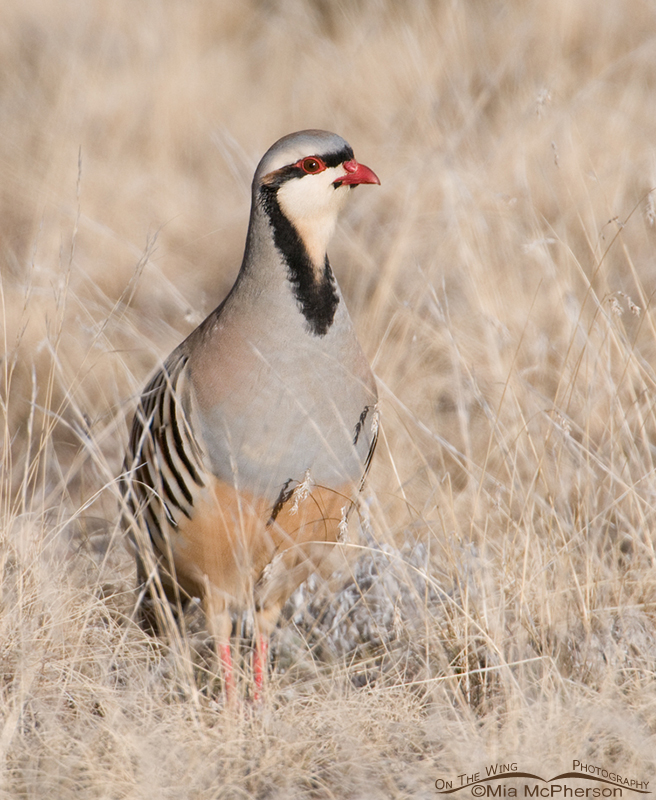 Chukar in grasses – Nikon D300, f6.3, 1/2500, ISO 640, Nikkor 200-400mm VR with 1.4x TC at 400mm, natural light
Chukar in grasses – Nikon D300, f6.3, 1/2500, ISO 640, Nikkor 200-400mm VR with 1.4x TC at 400mm, natural light
Chukars cluck like chickens so there are occasions when I hear them coming before I see them. With their pale buffy, tan and grey coloration they can blend in very easily with their habitat, even the black stripes on their flanks can be mistaken for shadows in the grasses.
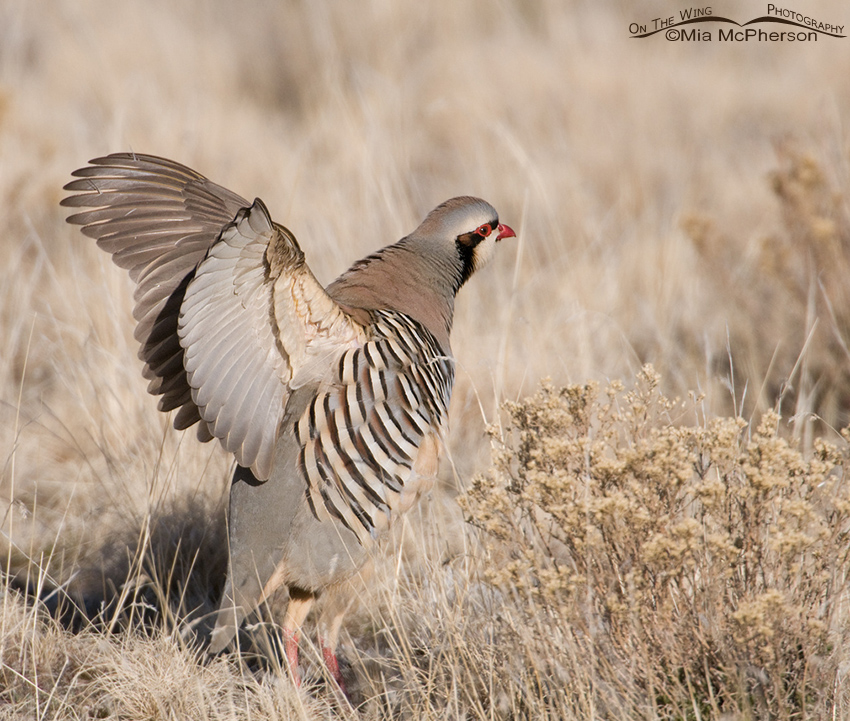 Chukar wing flap – Nikon D300, f6.3, 1/1250, ISO 640, Nikkor 200-400mm VR with 1.4x TC at 400mm, natural light
Chukar wing flap – Nikon D300, f6.3, 1/1250, ISO 640, Nikkor 200-400mm VR with 1.4x TC at 400mm, natural light
I often call Chukars “Rock Hoppers” because in the spring I see them hopping from the ground on to the tops of rocks and boulders to call. Other times the Chukars on top of the rocks appear to be sentinel birds, there to warn the other foraging birds of danger from predators. Even on the top of rocks and boulders they can be hard to spot, thankfully I have excellent long distance vision which usually serves me, and any one with me, well because frequently I see birds long before anyone else.
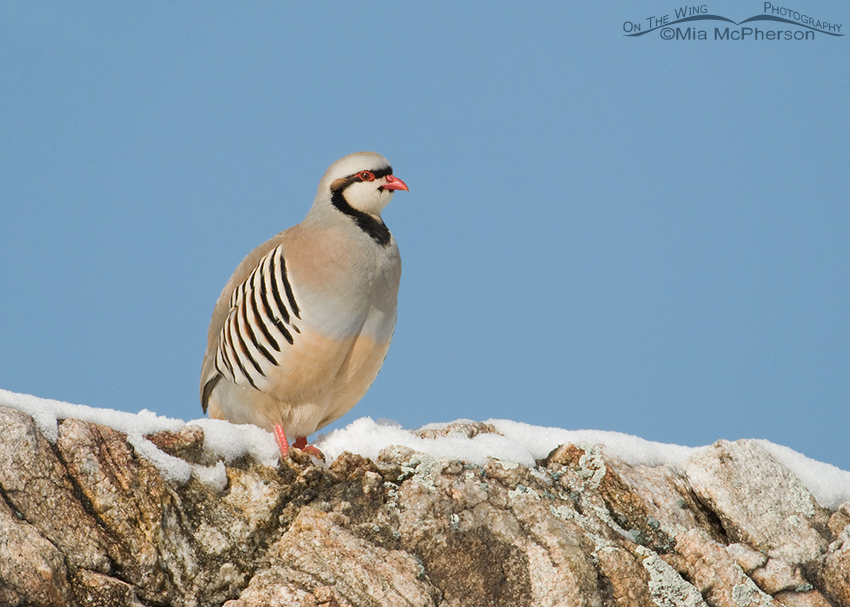 Chukar on snowy hilltop – Nikon D200, f6.3, 1/1600, ISO 400, +0.7 EV, Nikkor 200-400mm VR with 1.4x TC at 400mm, natural light
Chukar on snowy hilltop – Nikon D200, f6.3, 1/1600, ISO 400, +0.7 EV, Nikkor 200-400mm VR with 1.4x TC at 400mm, natural light
These birds do stand out well against snow and blue bird skies, though it is not often that I find them in those conditions. I am very fond of the series of images I took along with the frame above, the Chukar looks vibrant against the snow covered rocks, mountain and the clear blue of the sky.
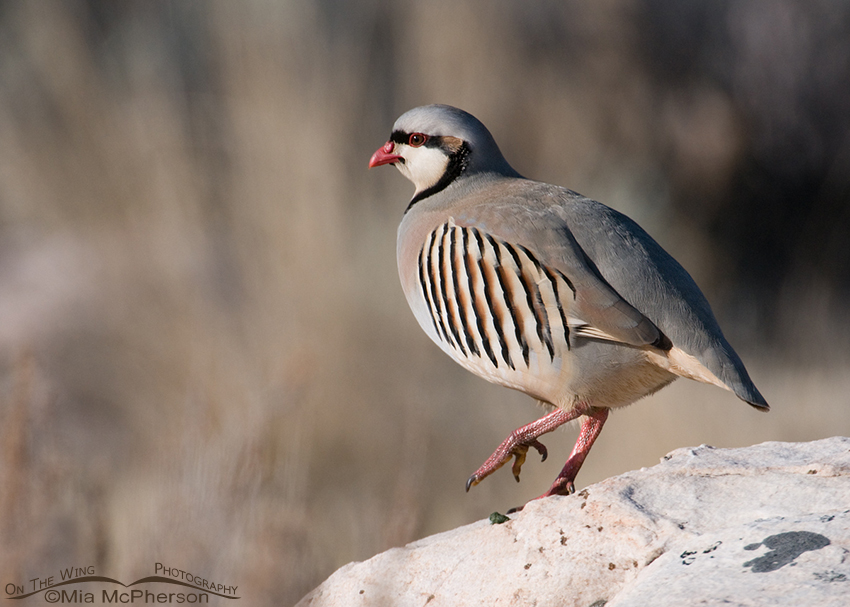 Chukar on the rocks – Nikon D300, f8, 1/1250, ISO 500, Nikkor 200-400mm VR with 1.4x TC at 400mm, natural light
Chukar on the rocks – Nikon D300, f8, 1/1250, ISO 500, Nikkor 200-400mm VR with 1.4x TC at 400mm, natural light
The grasses have begun to push green shoots from the ground here and the Chukars are calling more often from the tops of the rocks and I have witnessed a few skirmishes between the males. They will be nesting before too long.
Life is good.
Mia
Click here to see more of my Chukar photos plus facts and information about this species.





These birds are so interestingly marked and colored.
They are colored and marked in such a beautiful way Julie. I love that red bill too! Thank you for your comment.
Wonderful photographic series on this very colorful bird Mia, just killer images!
Thank you Chuck, we need to have you come back during the spring, these Chukars are really fun then as they sing from the tops of the rocks!
I agree with Linda Rockwell. What gorgeous photos of a magnificent bird. Great going, Mia!!
Thank you kindly Bob!
Beautiful birds and a wonderful post!
Thank you so much Susan.
I love Chukars … and the smell of sagebrush in the morning. We once took in a Chukar at the wildlife hospital, who’d been wandering the city streets. A lucky escapee from somewhere. We found him a good home.
We once took in a Chukar at the wildlife hospital, who’d been wandering the city streets. A lucky escapee from somewhere. We found him a good home.
Ingrid, I’m very glad you were able to find the wandering Chukar a good home. I only have to think of Sagebrush and I can almost smell it. Love it. Thanks for your comment.
Gorgeous images of a beautiful bird. It’s interesting to see the body feathers under the wings in the wing-flap shot.
Scott, I liked the wing flap image because it showed the underside too. They are beautiful birds. Thank you!
Very interesting looking birds! They seem like they would quite interesting subjects to observe. Your photos are outstanding and capture the detail of these birds perfectly.
Tammy, Chukars are fun to observe and listen too. Thank you for commenting.
Charming birds! These sentries of Antelope Island seem like a cross between a Killdeer and a Quail, beautiful.
Laurence, I liked your idea of the combination of Chukars, they do remind me a lot of California Quail. Thanks for commenting!
Wonderful post and absolutely knock-your-eyes-out photos Mia. I think I’ve missed several of your posts this week. I’ll have to go back and look at them. Don’t want to miss a thing!
Linda, thanks so much for your very kind comments and compliments on my images.
Gorgeous bird in gorgeous settings! Very nice Mia.
Thank you very kindly Robert1